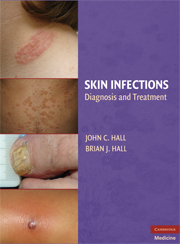Book contents
- Frontmatter
- Contents
- List of Contributors
- Acknowledgments
- INTRODUCTION
- TECHNIQUES IN DIAGNOSING DERMATOLOGIC MANIFESTATIONS OF INFECTIOUS DISEASES
- PRINCIPLES OF MANAGEMENT OF DERMATOLOGIC INFECTIONS IN THE SKIN
- PART 1 COMMON INFECTIONS
- PART II LESS COMMON INFECTIONS
- PART III INFECTIONS IN SELECTED ECOSYSTEMS
- PART IV INFECTIONS IN SELECTED PATIENT POPULATIONS
- 13 SKIN INFECTIONS IN HIV PATIENTS
- 14 INFECTIONS IN ORGAN TRANSPLANT PATIENTS
- 15 CANCER PATIENTS AND SKIN INFECTIONS
- 16 SKIN INFECTIONS IN PEDIATRIC PATIENTS
- 17 SKIN INFECTIONS IN THE ELDERLY
- 18 SKIN INFECTIONS IN ATHLETES
- 19 SKIN INFECTIONS IN DIABETES MELLITUS
- PART V INFECTIONS OF SPECIFIC SKIN-ASSOCIATED BODY SITES
- PART VI SPECIAL DISEASE CATEGORIES
- Index
14 - INFECTIONS IN ORGAN TRANSPLANT PATIENTS
from PART IV - INFECTIONS IN SELECTED PATIENT POPULATIONS
Published online by Cambridge University Press: 08 January 2010
- Frontmatter
- Contents
- List of Contributors
- Acknowledgments
- INTRODUCTION
- TECHNIQUES IN DIAGNOSING DERMATOLOGIC MANIFESTATIONS OF INFECTIOUS DISEASES
- PRINCIPLES OF MANAGEMENT OF DERMATOLOGIC INFECTIONS IN THE SKIN
- PART 1 COMMON INFECTIONS
- PART II LESS COMMON INFECTIONS
- PART III INFECTIONS IN SELECTED ECOSYSTEMS
- PART IV INFECTIONS IN SELECTED PATIENT POPULATIONS
- 13 SKIN INFECTIONS IN HIV PATIENTS
- 14 INFECTIONS IN ORGAN TRANSPLANT PATIENTS
- 15 CANCER PATIENTS AND SKIN INFECTIONS
- 16 SKIN INFECTIONS IN PEDIATRIC PATIENTS
- 17 SKIN INFECTIONS IN THE ELDERLY
- 18 SKIN INFECTIONS IN ATHLETES
- 19 SKIN INFECTIONS IN DIABETES MELLITUS
- PART V INFECTIONS OF SPECIFIC SKIN-ASSOCIATED BODY SITES
- PART VI SPECIAL DISEASE CATEGORIES
- Index
Summary
Bacterial infections represent the major cause of morbidity in patients undergoing solid organ transplantation (SOT). Soft tissue infections from bacteria generally occur in the first month after transplantation when the skin is disrupted by the surgery itself or by indwelling catheters and lines. Incidence of wound infections in solid organ transplant patients ranges from 2% to 56%, depending on surgical technique, host characteristics, and antibiotic prophylaxis.
The skin flora is also the culprit when introduced to less tolerant tissue such as the transplanted organ itself. This can lead to pyelonephritis and cystitis in renal transplant recipients, cholangitis, and intra-abdominal abscesses in liver transplants, and bronchitis and pneumonia in the lung transplant recipient. Frequently, bacteremia ensues and may again come to the attention of a dermatologist as a subcutaneous abscess from hematogenous spread.
In the setting of immunosuppression, it is helpful to characterize pathogens by their pathophysiology:
pathogens – infection originating in skin and being typical of that which occurs in immunocompetent persons, albeit with the potential for more serious illness
pathogens – extensive cutaneous involvement with pathogens that normally produce trivial or well-localized disease in immunocompetent patients
pathogens – infection originating from a cutaneous source and caused by opportunistic pathogens that rarely cause disease in immunocompetent patients but that may cause either localized or widespread disease in compromised persons
of visceral pathogens – cutaneous or subcutaneous infection that represents metastatic spread from a noncutaneous site
With this framework, we will explore the common cutaneous bacterial pathogens.
- Type
- Chapter
- Information
- Skin InfectionsDiagnosis and Treatment, pp. 195 - 205Publisher: Cambridge University PressPrint publication year: 2009



